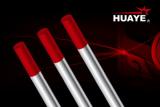2% thoriated tungsten electrodes (AWS classification EWTh-2) contain a minimum of 97.30% tungsten and 1.70 to 2.20% thorium. They are the most commonly used electrodes today and are preferred for their longevity and ease of use. Thorium increases the electron emission qualities of the electrode, which improves arc starts and allows for a higher current carrying capacity. This electrode operates far below its melting temperature, which results in a considerably lower rate of consumption and eliminates arc wandering for greater stability. It also features a lower level of weld contamination than other electrodes.
Unlike pure tungsten, these electrodes are only for specialty type AC welding (thin gauge aluminum or materials less than .060-in.), but they are exceptional for DC electrode negative or straight polarity on carbon and stainless steel, nickel and titanium applications.
During manufacturing, thorium is evenly dispersed throughout the electrode. This evenness allows the electrode to maintain a sharpened edge—the ideal electrode shape for welding thin steel. Sharpening the electrode’s point, however, should be done with great care. Thorium is radioactive; therefore, you must always follow manufacture’s warnings, instructions and the MSDS (Material Safety Data Sheet) for its use.
Application : Thoriated tungsten electrodes are generally used for welding of DC electrode negative or straight polarity applications such as carbon & stainless steels, nickel alloys and titanium, They operate well even when overload with extra amperage.
2% thoriated tungsten electrode(WT20)






 E-mail:
E-mail: